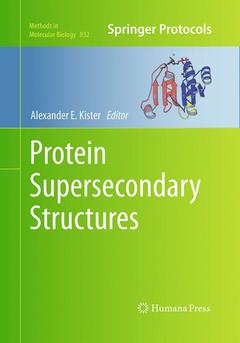Description
Protein Supersecondary Structures, Softcover reprint of the original 1st ed. 2013
Methods in Molecular Biology Series, Vol. 932
Coordinator: Kister Alexander E.
Language: English
Subject for Protein Supersecondary Structures:
Publication date: 08-2016
Support: Print on demand
Publication date: 09-2012
320 p. · 17.8x25.4 cm · Hardback
Description
/li>Contents
/li>Comment
/li>
Super secondary structure(SSS) helps to understand the relationship between primary and tertiary structure of proteins. In Protein Supersecondary Structure: Methods and Protocols expert researchers in the field detail the usefulness of the study of super secondary structure in different areas of protein research. This is done through four main studies SSS representation, SSS prediction, SSS and protein folding, and other application of SSS concept to protein biology. Written in the highly successful Methods in Molecular Biology? series format, chapters include introductions to their respective topics, lists of the necessary materials and reagents, step-by-step, readily reproducible laboratory protocols, and key tips on troubleshooting and avoiding known pitfalls.
Authoritative and practical, Protein Supersecondary Structure: Methods and Protocols highlight some of the major advances in the many fast-growing areas of supersecondary structure research.
Super-secondary Structure: A Historical Perspective.-Hierarchical Representation of Super-secondary Structures Using a Graph-theoretical Approach.-Up, Down and Around: Identifying Recurrent Interactions Within and Between Super Secondary Structures in b-Propellers.-Structure Description and Identification using the Tableau Representation of Protein Folding Patterns.-Computational Prediction of Secondary and Supersecondary Structures.-A Survey of Machine Learning Methods for Secondary and Supersecondary Protein Structure Prediction.-Beyond Supersecondary Structure: The Global Properties of Protein Sequences.-Creating Supersecondary Structures with BuildBeta.-A Modular Perspective of Protein Structures; Application to Fragment Based Loop Modeling.-Residue-residue Contacts: Application to Analysis of Secondary Structure Interactions.-Super-secondary Structures and Modeling of Protein Folds.-Computational Simulations of Protein Folding to Engineer Amino Acid Sequences to Encourage Desired Supersecondary Structure Formation.-Protein Folding at Atomic Resolution: Analysis of Autonomously Folding Supersecondary Structure Motifs by Nuclear Magnetic Resonance.-Artificial Supersecondary Structures Based on Aromatic Oligoamides.-Cross-b-sheet Super-secondary Structure in Amyloid Folds: Techniques for Detection and Characterization.-Analyzing Oligomerization of Individual Transmembrane Helices and of Entire Membrane Proteins in




